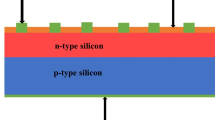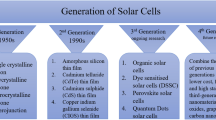Abstract
Effect of different gold (Au) grating structures on light absorption in solar cell is investigated by finite elemental analysis using COMSOL multiphysics-RF module. The geometry of the solar cell consists of a 50-nm Au film on the substrate of amorphous silicon (a-Si). An optimum value of the slit width (w) of the Au grating has been obtained whereas periodicity of the grating structure remained the same. The periodicity in the grating device was chosen in such a way that the excitation of the surface plasmon polritons (SPPs) lies in the IR or NIR region where most of the spectrometers work well in practical life. Far-field transmission spectra were extracted from the grating device when illuminating with p-polarized light through the substrate side. Near-field plots of the Fano resonance (dip) associated with the excitation of the surface plasmon polritons (SPPs) were carefully examined to understand the underlying physics. It was deduced from the results that a grating device with slit width of 250–350 nm is the most efficient which reveals the fact that such device offers intermediate scattering from the grating structure and supports fundamental plasmonic mode. Hence, such devices absorb more light being most efficiently and find application in solar cell.









Similar content being viewed by others
References
Furlan J et al. (1989) a-Si versus c-Si material and solar cells similarities and differences. In Electrotechnical Conference. Proceedings. ‘Integrating Research, Industry and Education in Energy and Communication Engineering’, MELECON’89. Mediterranean. 1989. IEEE
Rao J, Varlamov S (2013) Light trapping in thin film polycrystalline silicon solar cell using diffractive gratings. Energy Procedia 33:129–136
Nakayama K, Tanabe K, Atwater HA (2008) Plasmonic nanoparticle enhanced light absorption in GaAs solar cells. Appl Phys Lett 93(12):121904
Pala RA, White J, Barnard E, Liu J, Brongersma ML (2009) Design of plasmonic thin-film solar cells with broadband absorption enhancements. Adv Mater 21(34):3504–3509
Shen H, Maes B (2011) Combined plasmonic gratings in organic solar cells. Opt Express 19(106):A1202–A1210
Thio T, Ghaemi HF, Lezec HJ, Wolff PA, Ebbesen TW (1999) Surface-plasmon-enhanced transmission through hole arrays in Cr films. JOSA B 16(10):1743–1748
Atwater HA, Polman A (2010) Plasmonics for improved photovoltaic devices. Nat Mater 9(3):205–213
Raether H (1988) Surface plasmons on smooth surfaces, in Surface plasmons on smooth and rough surfaces and on gratings. Springer, p 4–39
Iqbal T (2015) Propagation length of surface plasmon polaritons excited by a 1D plasmonic grating. Curr Appl Phys 15(11):1445–1452
Iqbal T, Afsheen S (2016) Coupling efficiency of surface plasmon polaritons for 1D plasmonic gratings: role of under-and over-milling. Plasmonics 11(5):1247–1256
Palik ED (1984) Handbook of optical-constants, p 1
Adachi S (2013) Optical-constants of crystalline and amorphous. Semiconductors
Sommerfeld A (1899) Ueber die Fortpflanzung elektrodynamischer Wellen längs eines Drahtes. Ann Phys 303(2):233–290
Zenneck J (1907) Über die Fortpflanzung ebener elektromagnetischer Wellen längs einer ebenen Leiterfläche und ihre Beziehung zur drahtlosen Telegraphie. Ann Phys 328(10):846–866
Vempati S, Iqbal T, Afsheen S (2015) Non-universal behavior of leaky surface waves in a one dimensional asymmetric plasmonic grating. J Appl Phys 118(4):043103
Javaid M, Iqbal T (2016) Plasmonic bandgap in 1D metallic nanostructured devices. Plasmonics 11(1):167–173
Koev ST, Agrawal A, Lezec HJ, Aksyuk VA (2012) An efficient large-area grating coupler for surface plasmon polaritons. Plasmonics 7(2):269–277
Iqbal T, Afsheen S (2016) Extraordinary optical transmission: role of the slit width in 1D metallic grating on higher refractive index substrate. Curr Appl Phys 16(4):453–458
Iqbal T, Afsheen S (2017) One dimensional plasmonic grating: high sensitive biosensor. Plasmonics 12(1):19–25
Billaudeau C, Collin S, Pardo F, Bardou N, Pelouard JL (2009) Tailoring radiative and non-radiative losses of thin nanostructured plasmonic waveguides. Opt Express 17(5):3490–3499
Ye Y, Zhenxi Z, Dazong J (1997) Numerical calculation of MIE scattering. J Appl Optics 4:003
Iqbal T, Afsheen S (2016) Plasmonic band gap: role of the slit width in 1D metallic grating on higher refractive index substrate. Plasmonics 11(3):885–893
Miroshnichenko AE, Flach S, Kivshar YS (2010) Fano resonances in nanoscale structures. Rev Mod Phys 82(3):2257–2298
Genet C, van Exter MP, Woerdman J (2003) Fano-type interpretation of red shifts and red tails in hole array transmission spectra. Opt Commun 225(4–6):331–336
Worthing P, Barnes WL (2001) Efficient coupling of surface plasmon polaritons to radiation using a bi-grating. Appl Phys Lett 79(19):3035–3037
Moreland J, Adams A, Hansma PK (1982) Efficiency of light emission from surface plasmons. Phys Rev B 25(4):2297–2300
Iqbal T (2017) Coupling efficiency of surface plasmon polaritons: far-and near-field analyses. Plasmonics 12(1):215–221
Romanato F, Ongarello T, Zacco G, Garoli D, Zilio P, Massari M (2011) Extraordinary optical transmission in one-dimensional gold gratings: near-and far-field analysis. Appl Opt 50(22):4529–4534
Cao Q, Lalanne P (2002) Negative role of surface plasmons in the transmission of metallic gratings with very narrow slits. Phys Rev Lett 88(5):057403
Rosengart E-H, Pockrand I (1977) Influence of higher harmonics of a grating on the intensity profile of the diffraction orders via surface plasmons. Opt Lett 1(6):194–195
Author information
Authors and Affiliations
Corresponding authors
Rights and permissions
About this article
Cite this article
Iqbal, T., Ijaz, M., Javaid, M. et al. An Optimal Au Grating Structure for Light Absorption in Amorphous Silicon Thin Film Solar Cell. Plasmonics 14, 147–154 (2019). https://doi.org/10.1007/s11468-018-0787-2
Received:
Accepted:
Published:
Issue Date:
DOI: https://doi.org/10.1007/s11468-018-0787-2




